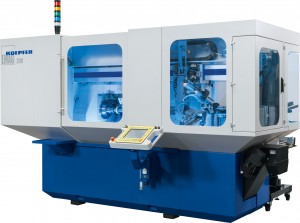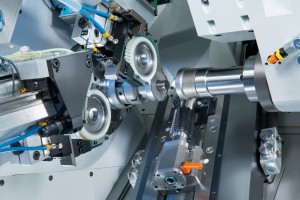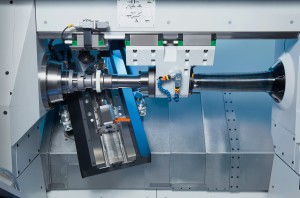The machine acts as an universal solution for the manufacture of a multitude of geared components

The gear is one of the earliest machine components in the history of mankind. For thousands of years, gears have served the purpose of movement and power transmission – first the power of flowing water, then that of steam and today numerous kinds of energy sources. It is unimaginable that transport as we know it would be what it is today without gears. Geared components play a central role and are used in a large variety of systems, for example in the powertrain, in steering systems and for on-board electronics, such as seat ergonomics. It is this variety of shapes and materials of gears that have the manufacturers asking how to economically produce these components at the required quality. The engineers from EMAG KOEPFER were facing this question too and have come up with the K 300 Hobbing Machine – a universal solution for gear production.
“We have created a machine that represents a fully-fledged universal solution. A number of equipment variants and options make sure that the K 300 can be used in many sectors of gear manufacture,” explains Jörg Lohmann, Head of Sales at the EMAG subsidiary KOEPFER. The wide range of workpieces that can be machined (geared) on the K 300 covers everything from pinion shafts module 1 to helical gears module 4. Equally wide is the range of materials the machine can handle – from steel alloys and aluminium to brass, bronze and even plastics.
Built-in quality
The construction of the K 300 is designed for the highest component quality with a machine base of polymer concrete. In conjunction with the closed-box design that has headstock and tailstock connected by a yoke and the whole enclosed in a box-frame, it provides the highest possible degree of rigidity and precision during the gear cutting process. The hobbing head, inclined by 45 degrees, offers optimal chip flow conditions, which play their part in the quality of the component produced. This also eases access for the machine setter. The machine accommodates a variety of gear cutting technologies, such as high-performance wet and dry hobbing, the skiving and hard milling of cylindrical gearings, as well as the plunge and tangential hobbing of worm gears. It also allows for the cutting of straight bevel gears using either form milling cutters in a multi-step process or Conikron hobs. Even out-of-round gearings can be machined on the K 300.
Water-cooled direct drives on all process-relevant axes ensure a fast machining process and the best machining quality, as the play in mechanical transmission elements is eliminated. Additional tasks are handled by auxiliary NC-axes that carry out jobs such as deburring and brushing or use sensors that guarantee the gearing is aligned correctly with markings, bores, secondary gearings, cams or other features. The well thought-out design of the K 300 is rounded off by the position of the electrical cabinet,which is located behind the machine, and the optimal mass distribution of main spindle and tailstock. Both ensure excellent thermal stability and thus a stable process, even in large batch production.
Fast production start-up
The ergonomic construction allows easy access to all relevant machine components. For instance, the setter can, with the help of quick-clamping systems for main spindle, tailstock and hob, set up the machine on a brand new part in less than 20 minutes. For this process, all settings, from tailstock clamping force to the positions of automation equipment components, are entered in the NC-program using the teach-in function. The K 300 features up to 15 NC-axes that help achieve short setup times. They are supplemented by the ultra-fast KOEPFER loading device with V-gripper that, in its standard execution, can handle workpieces of up to 10 kg. Raw-part and finished component magazines (eg. gravitational and chain magazines), re-circulating storage conveyors and workpiece storage systems (eg. cleat conveyors) are also available. Fully-automated robot cells with paletting systems can also be supplied, where required.
For universal use
The machine specification offers a wide range of technologies, including suction units for dry machining, oil-mist extractors for wet machining, a variety of deburring systems, vibration dampers for shaft machining, sensors for the automatic alignment of components or for skiving operations, and much more. The flexibility with which the K 300 can be used becomes even clearer when one takes a look at present applications. The machines are, of course, used by the sub-suppliers of the automotive industry, but certainly not them alone. Contract gear manufacturers, reduction gear producers, hydraulic component manufacturers and production facilities in the aero-space supply chain all use this high-tech solution. Whether you are machining large batches of transmission components or small batches of plastic gears, the K 300 can be equipped to suit your particular requirements. Lohmann adds, “We can configure the K 300 to suit almost every customer requirement, whether it calls for a manually loaded stand-alone machine or a fully automated manufacturing system.”
Advantages
Precise: Direct drives in all process-relevant axes
Sturdy: Box-frame design and thermo-symmetrical construction
Flexible: Hobbing, skiving, hard milling, plunge and tangential milling, the milling of bevel gears using the multi-step method or Conikron hobs and out-of-round hobbing.
Automated: Inclusive gantry loader, as well as raw-part and finished component magazines
Setter-friendly: Setting up of a new workpiece sometimes concluded in under 20 minutes
Comprehensive: Auxiliary NC-axes for deburrers, vibration dampers, sensor carriers and much more.












how to set up google alerts
Thanks for every other informative website. Where else
could I get that kind of info written in such a
perfect manner? I’ve a project that I’m just now running on, and I have been on the look out for
such information.